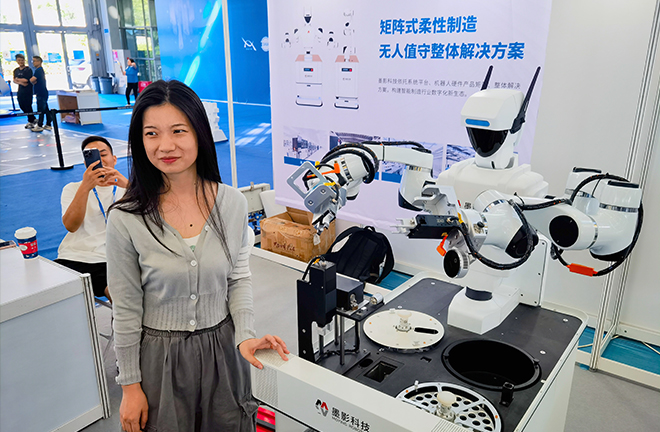AI from the perspective of semiotics

The 4th Shenzhen Global Artificial Intelligence Expo was held on Oct. 12-14 in Shenzhen, Guangdong Province. Photo: Chen Wen/CNSphoto
With the emergence of increasingly intelligent and human-like machines, the field of semiotics in the era of artificial intelligence is beginning to explore the symbolic operating mechanisms generated through human-machine interaction. Combining elements of AI technology with semiotic narratology, semiotic aesthetics, and semiotic ethics can help expand the frontiers of semiotic studies, as well as develop new understandings of AI.
Mechanisms of narrative generation
AI semiotic narratology primarily examines the mechanisms of narrative generation and communication unique to intelligent machines. AI-generated narrative texts have now become commonplace. In theory, highly intelligent AI can reproduce almost all narrative forms through various symbolic media. The basic symbolic operating rules of machines are based on binary algorithms, but the human brain does not solely rely on rational thinking. Instead, it has distinctive emotional and illogical tendencies.
Humans have a natural ability to create stories, and once a story is typified, storytellers will design new plots to break previous patterns, thus continuously creating new narrative types. The impulse to constantly break established narrative rules and reconstruct narrative rules gives rise to endless story innovations. This innovative driving force can be seen as the capability of “meta-narration,” which machines do not possess.
However, this does not mean that narrative content generated by intelligent machines cannot produce meaning. While machines are unable to create meaning the way humans do, nor relate to the emotions and experiences described in stories, they can imitate existing narrative types created by humans. AI is now capable of generating professional-level poetic texts and various types of narrative texts.
In human-machine communication, recipients of the narrative are human subjects, and different audiences respond to the narrative content generated by intelligent machines through diverse feedback. The key to this process is whether or not information recipients identify with the narrative content. If machine-generated narrative content resonates with audiences, meaning can be constructed in reverse.
Quasi-artistic expression
AI symbolic aesthetics attempts to reveal the aesthetic qualities embodied by intelligent machines in symbolic activities from a semiotic perspective. AI is now performing impressively well in artistic fields such as painting, music, and calligraphy. It is able to imitate artistic forms with amazing accuracy. However, this does not mean that machines understand the principles of art or appreciate its beauty.
Machines have not yet mastered the “meta-language” of art, namely self-reflection and transcendence regarding art itself. Machine-generated art is still an “art-like product” created through the processing of pre-set parameters and data models provided by human designers. It is actually a form of “quasi-artistic expression” produced by processing human artistic expression, and its aesthetic significance can be recognized by human subjects.
While AI is not yet capable of moving beyond existing artistic styles and engaging in original artistic creation as human artists do, it can project aesthetic qualities resembling human artwork and convey a sense of beauty to the audience. AI art can realize symbolic value at the artistic level, if “art-like products” evoke aesthetic emotions in the audience.
Quasi-subject awareness
AI symbolic ethics attempts to analyze the intertwined relationships between human subjects, intelligent machines, and the world from a semiotic perspective, while also building a semiotic ethical system that can not only maintain human subjectivity, but also adapt to the future intelligent society.
The primary concern in AI symbolic ethics is the identification of the sending subject in symbolic activities, because only the sender is qualified to take ethical responsibility. Although it can communicate with humans in a convincingly realistic manner, AI is by its very nature an intelligent interactive system built upon algorithms and big data. Therefore, it does not have the same subjectivity as humans.
With technological advancements, AI could be endowed with “quasi-subject awareness” in the process of human-machine symbolic interaction. While “quasi-subject awareness” implies value judgment, it does not originate from machines themselves, which simply play an intermediary role in human symbolic expression.
Current AI can largely be understood as imitative intelligence. As it lacks the capability of “meta-signs,” which involves creating new signs by reflecting upon the expressive principles, imitative intelligence is unqualified to serve as ethical subjects in symbolic activities. However, machines may one day develop subject awareness similar to that of humans and acquire the capability of “meta-signs.”
Should machines be truly able to understand what “meaning” is and fully decipher the human symbolic world, they must assume the responsibility of subjects. Human-machine relationships are not distinct self-other relationships, and human symbolic capabilities will gradually evolve with technological progress. As human-machine interactive technology increasingly matures, a “symbiotic subjectivity” of “you within me, me within you” could emerge between humans and machines, leading to the formation of new intelligent symbolic systems.
Huang Wenhu is an associate professor from the School of Journalism and Communication at Huaqiao University.
Edited by WANG YOURAN
